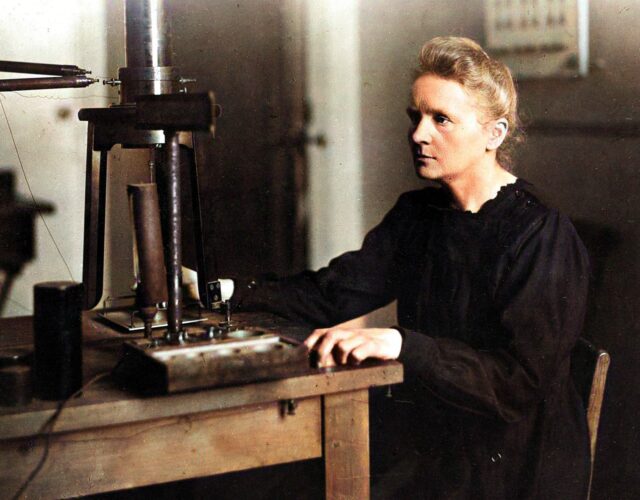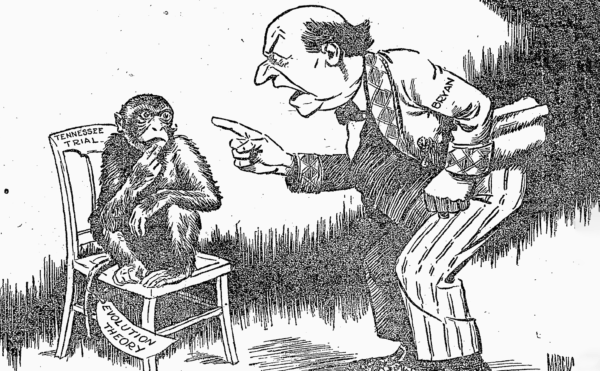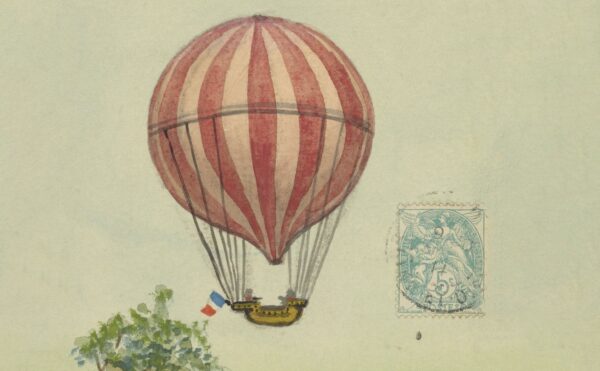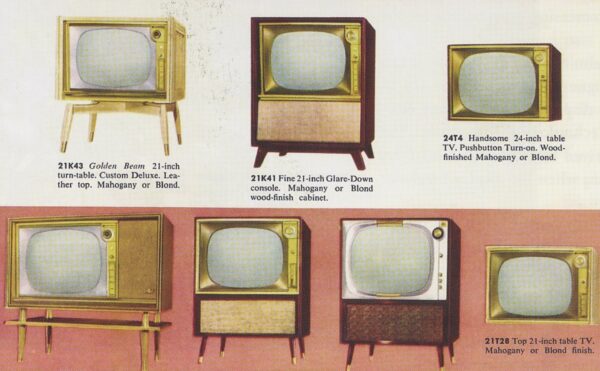Radium was once the trendiest element in the world. It glowed alluringly in the dark and was hailed it as a medical panacea. It was also the basis of Marie Curie’s research—for which she won her second Nobel Prize in 1911. But by 1920 radium was scarce and its cost was eye-popping: one hundred thousand dollars per gram. When Curie’s research ground to a halt because of the expense, thousands of American women stepped in to raise money for the precious chemical element.
Credits
Host: Sam Kean
Senior Producer: Mariel Carr
Producer: Rigoberto Hernandez
Audio Engineer: Jonathan Pfeffer
Music:
- Krzysztof Penderecki – Fonogrammi
- Krzysztof Penderecki – Concerto for Cello and Orchestra No. 1
- Peter Cusack – Radiometer, Kopachi
- Wojciech Rusin – Fox Glove
- Einsturzende Neubauten – Negativ Nein
- Anthony Braxton – 22 M
- George Gershwin – Rhapsody in Blue
- Sachiko M – Don’t Touch
- Marc Barreca – Vs Chorus
- All other music composed by Jonathan Pfeffer
Transcript
Marie Meloney wasn’t used to feeling nervous. She’d started reporting for the Washington Post at age 17, and she was the first woman to win a seat in the U.S. Senate press gallery.
By May 1920 she was editing a popular American magazine, The Delineator. And on a press tour of Europe that year, she’d already interviewed War of the Worlds author H.G. Wells; Peter Pan author J.M. Barrie; and philosopher Bertrand Russell. She was a seasoned reporter and knew her stuff.
Still, when Meloney ascended the steps of the laboratory that day in Paris, she was nervous to meet Marie Curie.
Curie was not only an icon of modern science—the first person ever to win two Nobel Prizes. She was also a prickly personality, and had a combative relationship with the media.
In 1910, after Curie tried to win a seat in the French Academy of Sciences, some right-wing newspapers had started attacking her. Curie had been born in Poland, and according to the jingoistic press, a foreigner like her was unworthy of a seat in that august body.
Then, in 1911, reporters in Paris had exposed the widowed Curie’s love affair with the married physicist Paul Langevin . Curie’s husband Pierre had died a few years earlier in a carriage accident, leaving Marie alone. Langevin was unhappy with his marriage, so the two scientists poured their passions into each other.
Unfortunately Langevin’s wife opened their private love letters and sent them to a newspaper, which published excerpts.
One from Marie read “When I know that you are with [your wife], my nights are atrocious, I can’t sleep.” Langevin’s wife then threatened to murder Curie in the street. Langevin himself challenged the publisher to a duel. All in all, it was an exhausting, humiliating ordeal.
Ever since then, Curie had loathed the press, and Marie Meloney felt anxious about intruding that morning in 1920. So you can imagine Meloney’s surprise at what happened next. Even before she could ask her first question, Curie flipped the script and started interrogating her. What, she asked the editor, do you know about radium?
<MUSIC>
From the Science History Institute this is Sam Kean and the Disappearing Spoon—a topsy-turvy science-y history podcast. Where footnotes become the real story.
<GEIGER COUNTER CRACKLING>
Although it’s pretty obscure today, radium was once the trendiest element in the world. It glowed alluringly in the dark, which made it perfect to illuminate watch dials, roulette wheels, fishing lures, and other consumer goods.
And at this time, radioactivity still seemed mysterious and otherworldly. People in fact hailed it as a medical panacea. Radium appeared in quack cures for everything from bad breath to depression, and drugstores carried radium-infused hair tonics, bath salts, face creams, and even condoms and suppositories. It got you coming and going.
Marie Curie had been linked to radium ever since she and her late husband Pierre had discovered it in 1898. They’d toiled for years at the task, refining and processing literal tons of mineral ore to extract a single gram of this element.
That gram won Curie the 1911 Nobel Prize, her second. And as the basis of much of her research, it was the most precious thing in the world to her. When World War I erupted in August 1914, she actually stayed in Paris to protect the radium, despite the threat of the invading German army. Later, she personally escorted the gram to Bordeaux in western France for safekeeping.
But war heroics weren’t what Curie wanted to talk to the editor Marie Meloney about. She wanted to talk about the eye-popping cost of radium—over $100,000 per gram. That’s $1.3 million today.
Curie couldn’t afford to purchase any more as a result. Worse, the French government had appropriated Curie’s original gram and redirected it to doctors to treat tumors. As a result, the very woman who’d discovered radium had seen her research grind to a halt for a lack of it.
Curie spilled all this to Marie Meloney before the interview even started. After this outpouring, the interview proceeded and Meloney’s story appeared a few months later. In it, she called Marie “the greatest woman in the world,” praising her as both a brilliant scientist and a “woman of rare beauty.”
Upon returning to New York, though, the editor couldn’t stop thinking about Curie’s difficulties. The high price of radium had shocked her—as had the dilapidated state of Curie’s lab. Meloney had interviewed other scientists before—Thomas Edison, Alexander Graham Bell. And compared to their labs, Curie’s equipment looked like junkyard scraps. It wasn’t right.
So with typical moxie, Meloney decided there was only one thing to do. If France wouldn’t support Marie Curie properly, then the United States of America would. Meloney would just have to buy a gram of radium of herself.
Meloney had always been politically active. Her mother had actually founded a school for freed slaves, and the daughter had absorbed her mother’s activism. So Meloney began working her network of contacts on Curie’s behalf. She first asked the wives of ten wealthy businessmen to donate $10,000 each.
All ten turned her down. Undeterred, Meloney made a virtue of necessity and cast her net wider. She would make her fundraising more democratic, and appeal directly to the women of America.
American women had won the right to vote in 1920 and were feeling proud. Meloney harnessed this energy by penning a plea in her magazine to support Curie, as a pioneering female scientist. “[L]ife is passing,” she wrote, “and the great Curie getting older, and the world is losing, God alone knows, what great secret.”
As for the logistics of raising money, Meloney modeled her campaign after fundraising efforts for the Statue of Liberty monument in the 1880s.
The statue itself had been a gift to the United States, but the U.S. still had to pay for the pedestal. And the fundraising effort had relied on everyday people, rallied by newspaper magnate Joseph Pulitzer. He offered to publish the name of every single person who donated ,even if they gave a single penny. The drive eventually raised $100,000 from 120,000 people.
Marie Meloney followed this model. She assembled brigades of housewives to knock on doors nationwide on Curie’s behalf, collecting a dollar here, two dollars there. Schoolgirls also chipped in, scrounging for dimes and sending those along.
The campaign’s success surprised even Meloney—she ended up outdoing even the Statue of Liberty drive. Coins and dollar bills poured in, and when the final pennies were totted up, she’d raised $156,000—two million dollars today. Meloney quickly secured a bid for a $100,000 gram of radium, and used the extra $56,000 to set up a trust fund for Marie and her daughters.
The radium drive helped announce American women as not just a political force, but a scientific and economic one. And in exchange for their help, Meloney thought it only fair for Curie to give something back. She invited the scientist to tour the United States, and let the women of America see her.
Curie hesitated. She was a retiring person by nature, and her health was faltering after years of exposure to radioactive elements. She suggested limiting the tour to two weeks, tops.
Nonsense, said Meloney, who could be a little blithe. Seven weeks sounds more like the thing. Marie protested, but Meloney held firm. And Curie coveted the radium too much to say no. So in May 1921, she sailed to America with her two daughters—Irène, age 23, and Eve, age 16.
They docked in New York to find huge crowds awaiting them, including several troops of girl scouts. Well-wishers tossed roses, brass bands played. Curie end up shaking so many hands that day her arm began aching; it would end the seven-week tour in a sling.
For their part, Irène and Eve enjoyed America—swimming in Lake Michigan, touring Coney Island. Marie, though, quickly tired of the paparazzi as well as the endless litany of speeches and luncheons. She didn’t care about meeting Vanderbilts or Carnegies, and she began suffering from dizziness and a ringing in her ears.
At one point before a train ride in Santa Fe, a chaperone found her with her face buried in her hands. I can’t get on, she said. Not with people staring at me like a wild animal. But she did, and kept going for weeks afterward.
Observers noticed her plight. One reporter described how “her arms hung lifelessly [and] her features were ashen gray[.] The deep lines on her face … showed how seriously the unaccustomed strain of her whirlwind visit to America has affected her” Another warned of forcing Curie “to pay with her own flesh for our gift, the mere satisfaction of our pride.”
All that said, Curie did enjoy certain moments of the trip. She delighted in Niagara Falls and the Grand Canyon, which she’d always longed to see. And she was captivated with her tour of Standard Chemical Company near Pittsburgh, which had isolated the radium for her.
Scientists there spent six months on the job, using industrial-scale processes to whittle down 500 tons of ore into a single gram of silvery grey powder. Their method required 500 tons of acids and other chemicals, 1,000 tons of coal, and 10,000 tons of water. For comparison, Marie and Pierre had done all that work by hand in the 1890s.
Curie also met with President Warren Harding in a ceremony at the White House where she was presented with a protective case for the radium. The case was lined with lead and weighed 130 pounds. A gold key opened it. The press was led to believe that the radium was inside the case, but for security reasons, the gram was actually locked away at a nearby government lab. Curie played along, and in a short speech, she said she’d been honored “as no woman has ever been honored in America before. … I love you all, my American friends, very much.”
Exhausted, Curie arrived back in Paris on July 2nd. No doubt to her relief there were no crowds waiting for her. She could finally get back to work.
Over the next few decades, Curie and the scientists at her institute used the radium in several important research projects. Among those scientists was Curie’s daughter Irène and Irène’s husband and scientific partner, Frédéric Joliot.
Amusingly, before Irène and Frédéric married, Marie forced him to sign a prenuptial agreement renouncing all rights to the radium if he and Irène ever divorced. She needn’t have worried. Irène and Frédéric had a long, loving marriage, and an equally blessed scientific partnership.
In 1934, in fact, the gram helped them discover the first process for turning stable atoms into radioactive atoms, a key step in producing atomic chain reactions. This work won them the Nobel Prize in 1935.
Sadly, Marie Curie had passed away by then, from complications due to chronic radiation poisoning. The irony is sobering: she’d endured several exhausting weeks touring the United States simply to get her hands on more of the very substance that was killing her.
As for the gram of radium, it had a lively afterlife.
When Nazi Germany conquered Paris during World War II, Irène and Frédéric packed the radium into its 130-pound lead case and fled west to Bordeaux with it, just as Curie had done with the original gram at the start of World War I. Bravely, Irène later smuggled it back to Paris under the noses of the Nazis.
Later, Irène and her two children had to flee from war-torn France to Switzerland in June 1944. But they used money from the $56,000 trust fund that Marie Meloney had set up to survive in exile.
Meloney herself continued to be a force in American journalism. She scored coveted interviews with Benito Mussolini and Adolf Hitler in the 1930s. She also rose to the editorship of one of the biggest publications in the United States, the New York Herald-Tribune’s magazine.
In between work she also continued to champion the Curies. She convinced New York mayor Fiorello LaGuardia to name a street after Curie in the Bronx. She then became something of a mentor to Curie’s daughter Eve, who aspired to write
Sadly, Meloney herself died in 1943. So she never got to hear how the trust fund had helped Irène and her children, the third generation of Curies to benefit from the largess of American women. But Meloney did get to hear how the gram had reinvigorated research at Curie’s institute.
And more than that, people close to Curie said that, despite the stress of the American tour, surviving the media glare gave Curie a new confidence in herself. Though never a bubbly person, she emerged from the trip more at ease with crowds and more willing to engage with people.
She also had a deeper understanding of what she meant to women across the world. Whatever radium had cost her, what Marie Curie had given them was priceless.
This is the Disappearing Spoon podcast, brought to you by the Science History Institute. Find out more about their library, museum, and multimedia magazine at sciencehistory.org.
Make sure you check out the Science History Institute’s other awesome podcast, Distillations. You can find their in-depth narrative stories and interviews about everything from Space Junk to Sex, Drugs, and Migraines anywhere you get your podcasts, and on their website: Distillations.org.
You can find more incredible stories from my books at samkean.com. You can also book me as a speaker at your school or event.
If you like this podcast, please support it at patreon.com/disappearingspoon. It costs as little as seven cents per day. You can also get bonus episodes and signed books.
Please spread the word to others as well, and subscribe in iTunes, Stitcher, or other places.
This episode was written by me–Sam Kean. It was mixed by Jonathan Pfeffer, and produced by Mariel Carr and Rigoberto Hernandez.
Thanks for listening…




